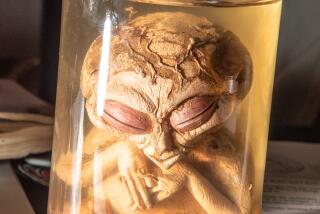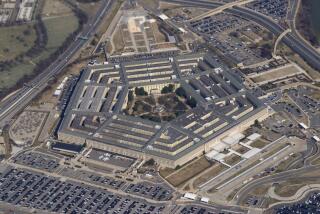Roswell UFO museum’s fascinating space
Reporting from Roswell, N.M. — As head of the International UFO Museum and Research Center in Roswell, Julie Shuster has heard every imaginable story about flying saucers, aliens and cover-ups. But one stands out.
She recalled standing near the ticket counter and hearing a visitor recount the tale of how the Army public information officer who first released details of a crashed “flying disk” had been permanently silenced.
As the anecdote progressed to conspiracies about the soldier’s mysterious disappearance, Shuster felt compelled to interrupt. She repeatedly told the man his account was untrue.
He continued to claim he was right until the museum director uttered five words.
“That man was my father,” she told him.
For decades after the discovery of what many think was an alien spaceship on a ranch about 40 miles outside Roswell, few people in town talked about it. In fact, Shuster didn’t learn of it until 1980, when a book detailing the mysterious happenings was published that included her dad’s account of what he had seen.
“At first, it was hard to believe,” she said. Now, though, she is convinced something otherworldly did descend on her hometown.
“The focus of the museum is to provide information,” she said. “We don’t care whether you believe or disbelieve.”
The museum, with an adjacent research facility for scholars, opened 20 years ago. Among its founders was Shuster’s father, Walter Haut. In 1947, as public information officer for Roswell Army Air Field, he was dispatched to the crash site. Years later, he told of seeing nonhuman creatures among the wreckage.
According to his daughter, Haut started the museum because “people were curious. People wanted information.”
Fellow museum founder Glenn Dennis was a Roswell undertaker at the time of the incident. He too had a personal connection.
“[Dennis] was contacted for ‘small, youth-sized caskets,’” Shuster recalled. “When he asked if there had been an accident, they [military officers] said, ‘Don’t worry about it.’”
Attendance has soared from 1,400 visitors in 1991 to more than 153,000 in 2010. Shuster said that, on average, she welcomes guests from all 50 states and more than 30 foreign countries each month.
If you’re looking for pictures of debris or government photos, you’re apt to be disappointed. But what the museum does have are various newspaper and radio reports from July 1947, along with replicas of the debris and depositions from those involved.
One piece of the puzzle came from Homer Rowlette Jr., an Army sergeant who helped with cleanup at the crash site. His “confession” — as an exhibit describes it — came on his deathbed: “I saw three little people. They had large heads and at least one was alive.”
Rancher Mack Brazel told reporters he discovered the wreckage and alien remains on the morning of July 5. The story, with details provided by Haut, broke in the Roswell Daily Record three days later. The following day, however, the military did an about-face.
The debris had been taken to an Army air field near Fort Worth, where a general issued a statement. The discovery was, according to an Associated Press article, “a harmless high-altitude weather balloon.”
In a second, front-page story in the Daily Record, on display in the museum, rancher Brazel disputed that.
“I am sure what I found was not any weather observation balloon,” he said.
What really happened is up to each guest to decide. What’s certain — to spin a phrase from the “X-Files” — is that the truth is in there.
More to Read
Sign up for The Wild
We’ll help you find the best places to hike, bike and run, as well as the perfect silent spots for meditation and yoga.
You may occasionally receive promotional content from the Los Angeles Times.






